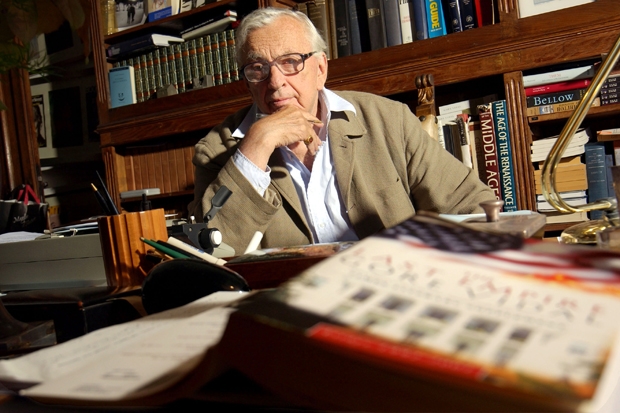History for Gore Vidal was a vehicle to be ridden in triumph, perhaps as in an out-take from Ben-Hur, which he worked on during one of his stints as a Hollywood hack, camping up the script to annoy Charlton Heston. Not only did he ride the Vehicle of History, but as its amanuensis and avatar, born and raised to the purple, in his mind he somehow was History, and of his many achievements the greatest was to persuade others to share that belief. His career presents the realised fantasy of the charismatic narcissist, which is to be taken at one’s own estimation. The American writer and academic Jay Parini, who was a friend of his from the 1980s, remembers him saying, ‘I might have been president’, but the presidency would not have been enough. Much in demand as a godfather, he once lamented, ‘Always a godfather, never a god.’
Parini calls his biography ‘a frank yet fond look at a man I admired, even loved’. Though broken up by embarrassing ‘vignettes’ of their times together (‘ “Maestro,” I say, kissing Gore on each cheek…’), his narrative is otherwise conventionally chronological.
Eugene Luther Gore Vidal ‘had a profound sense of his aristocratic lineage’, but as his first biographer, Fred Kaplan, pointed out to his fury, his lineage was not remotely aristocratic. His father, Eugene L. Vidal (‘Big Gene’ to our hero’s ‘Little Gene’ — how he must have hated that!), was ‘a farm boy’ who attended West Point, became a professional footballer and went into aviation, helping to found the Ludington Line (eventually absorbed into TWA), where he hired and bedded Amelia Earhart, of whom, as of so many historical figures, Vidal had anecdotal memories.
His mother was Nina Gore, daughter of Thomas Pryor Gore, a lawyer from Mississippi who became a senator for Oklahoma. Like her husband she had affairs, and in the year of their divorce (1935, when Little Gene was ten) she married ‘Hughdie’ Auchincloss, an heir to Standard Oil, whose stepdaughter, Jacqueline Bouvier, would supply Vidal with his grossly exaggerated connection with the Kennedys.
Parini echoes Vidal’s account in Palimpsest, his first volume of memoirs, of how he was brought up by his maternal grand-parents at their house in Washington, where he read Herodotus, Gibbon and Henry Adams. At St Albans, a local prep school, he fell in love with a boy called Jimmie Trimble, who was killed at Iwo Jima and became his lifelong erotic obsession. In The City and the Pillar (1948) Trimble features as the straight love object, killed at the end by the Vidal character for resisting his advances. Years later Vidal gave the story a new ending, in which he rapes him instead of killing him, which was nice of him.
Vidal deplored the term ‘gay’, preferring ‘degenerate’ and viewing himself as ‘a heterosexual man who liked to “mess around” with men’. Parini says he ‘never acted like a gay man’, though Howard Austen, his partner for more than half a century, recalled that whenever they were in England and the National Anthem was played, ‘Gore would stand up and wave’. But for all his queenly ways he resisted classification to the end. When a grande dame greeted him at a literary festival in Florida in 2009 with ‘Mr Vidal, I consider you one of the great homosexuals of our time,’ he said to Parini, ‘Will someone please get this cunt out of my sight?’
In 1940, as a pupil at Hughdie’s old school, Phillips Exeter Academy, Vidal adopted the oratorical position he would deploy for the rest of his life, declaring, in a speech attacking FDR: ‘This nation has at last come under the regime that has been foretold by our forefathers as the Armageddon of American democracy and freedom.’
Senator Gore had opposed US involvement in the Great War, and as an ardent America Firster his grandson took the same line on the second world war. Nevertheless, until invalided out, he served as first mate aboard a transport ship in the Aleutian Islands, which gave him the material for his first novel, Williwaw (1946).
He turned out fiction at a furious rate, sometimes under suggestive pseudonyms such as Edgar Box and Katherine Everard, but it was with his 14th novel, Julian (1964), that he found his metier as the Voice of History, in which role he went on to write his monumentally tedious Chronicles of Empire, charting American history from 1775 to 2000.
Devoted fanboy he may be, but even Parini is obliged to acknowledge that Vidal’s oeuvre is wildly uneven, and that ultimately he ‘was more a creature of publicity than literature’. Given the sheer volume of publicity he generated, as much by his feuds, opinions and ‘private’ life as by his work, this book feels rather belated and superfluous.






Comments